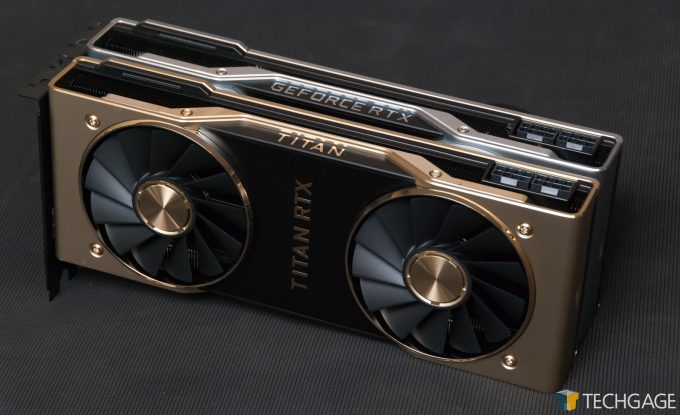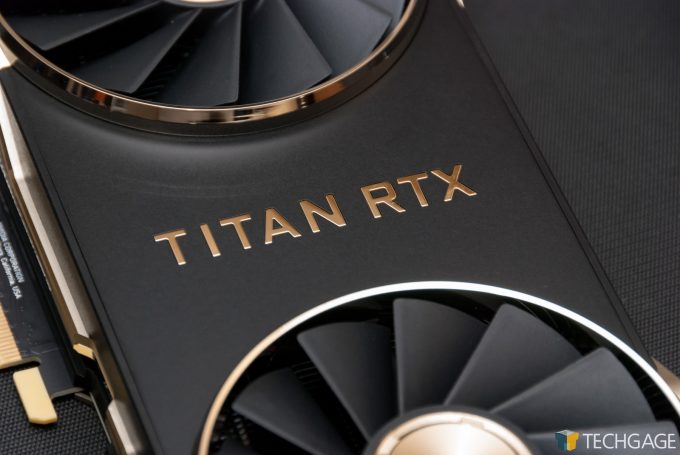- Qualcomm Launches Snapdragon 4 Gen 2 Mobile Platform
- AMD Launches Ryzen PRO 7000 Series Mobile & Desktop Platform
- Intel Launches Sleek Single-Slot Arc Pro A60 Workstation Graphics Card
- NVIDIA Announces Latest Ada Lovelace Additions: GeForce RTX 4060 Ti & RTX 4060
- Maxon Redshift With AMD Radeon GPU Rendering Support Now Available
NVIDIA TITAN RTX Workstation Performance Review

NVIDIA’s TITAN RTX means business – and a lot of it. This jack-of-all-trades graphics card caters to those with serious visual computing needs, whether it be designing and rendering 3D scenes, or poring over repositories of photos or other data with deep-learning work.
Page 7 – Final Thoughts
We had quite a bit of fun testing out NVIDIA’s TITAN RTX, and we’re presuming it’s not going to be hard to figure out why – and if it is, you probably didn’t look at the test results. As expected, the TITAN RTX delivered in droves across the board, proving to be the fastest card of the bunch overall – with a few exceptions where workstation-specific cards would take the lead.
With its $2,499 price tag, the TITAN RTX clearly isn’t targeting the world at large. It’s instead focusing on delivering the ultimate solution to those working with artificial intelligence and deep-learning, as well as those building the most complex visual projects. With a massive 24GB framebuffer on-board, memory is not likely to be a bottleneck for quite some time.
Memory is important in the ProViz market, but it seems even more important on the deep-learning side, since the datasets that are crunched through are simply enormous, and the more memory on tap, the more efficiently batch jobs could be cut through. In our previous testing and research, we found that NVIDIA’s Volta and Turing architectures are efficient at reducing deep-learning memory requirements, which means that 12GB on a Turing card could get you further than 12GB on a Pascal card. So with 24GB on the TITAN RTX, you’re going to have a lot of room to work with.
A big framebuffer is useful, but so too are the special RTX features found on the entire GeForce and Quadro RTX lines. On one hand, we have RT cores, which accelerates ray tracing workloads, both in gaming and in design. On the other, we have Tensor cores, which can dramatically improve deep-learning performance, as we discussed on the first page of this review. For ProViz, that can improve things like AI denoising performance in renders.
Unfortunately, we didn’t really dabble much at all into ray tracing or deep-learning in this article, but we do plan to explore its performance more, as we’re now discovering some benchmarks that would be easy enough to jump into and generate results for. A deeper look at this performance will likely come along with expanded ProViz coverage for Linux.
As mentioned before, we’re hesitant to call TITAN RTX an “ultimate” ProViz card, even though it certainly feels like it most of the time. The only reason we can’t is because it still lacks some of the Quadro optimizations. To get those, as well as an ECC bonus, you’d be opting for the $4,000 Quadro RTX 6000. For the heaviest of memory requirements, there’s also a Quadro RTX 8000, sporting an enormous 48GB framebuffer, retailing for $5,500.
For regular creators and modest research labs, gaming cards are going to prove to be an excellent value depending on the required workloads. For those heavier and more serious workloads, the TITAN RTX is a bit of a no-brainer. It carries an obvious cost premium, but it also boasts a massive framebuffer, as well as additional RTX accelerators that help bolster its performance in key workloads, like deep-learning and ray traced rendering. It’s a no-nonsense GPU for getting important work done.
In addition to future coverage of deep-learning perf, we’re also hoping to dive into RTX support in popular software suites as well, and report more on our experiences there. While not tested in this article, we are planning on tackling DaVinci Resolve performance soon, which with the current Studio 16 version supports RTX for AI touch-ups to video – and based on what we saw when we visited NVIDIA’s HQ in Taiwan during Computex, it’s really impressive technology.
If you’re still unsure about anything related to the TITAN RTX, or we failed to cover something here, please feel free to leave a comment. We will note that we will have another look at ProViz performance coming up soon, with newer drivers, although we haven’t witnessed any significant changes from the testing here. We do however have the latest SUPER and RX 5700 Navi GPUs included, so keep an eye out for that.
Support our efforts! With ad revenue at an all-time low for written websites, we're relying more than ever on reader support to help us continue putting so much effort into this type of content. You can support us by becoming a Patron, or by using our Amazon shopping affiliate links listed through our articles. Thanks for your support!







